Reaction to bring B.C. Transit’s recommendation to bring a $950-million electric light-rail transit system to the region was swift – and mixed.
"The issue right now is do our taxpayers have an opportunity to comment between now and when they want a decision on May 17?" asked Saanich Mayor Frank Loenard. "That's a pretty tight timeline on a $1-billion decision for taxpayers."
Transit is currently paid for by fares, the province, property and fuel taxes and some advertising. For light rail, Greater Victoria residential property owners would have to pay an additional $130 to $265 in transit taxes a year, depending on how much money from senior government can be secured.
Starting May 15, they currently will already be paying $120.50 for transit in 2011. Business owners, who will pay $386 a year in transit taxes, would see that climb to between $1,300 and $2,650.
"This needs to be a partnership from all three levels of government and we need to determine what that might look like, even find out how long it would take to get an answer from the provincial and federal governments," Leonard said. "Big picture, it's where we need to go. But there's some questions that need to be addressed from here to there."
Construction on major exchanges could begin at least two years after project approval, and it would be at least four or five years before a full system is operational.
A partial build-out of the line may help, said Saanich Coun Dean Murdock, who favours it going out to the 6 Mile/Colwood interchange for $770 million.
“What’s clear here is there is no option to do nothing. There is no cheap way out of this,” he said.
“If we don’t take it all the way out to the Langford exchange at Station Avenue, we start to erode the attraction for people to get on the LRT.”
The Greater Victoria Chamber of Commerce is reserving judgement until it can go over the plan with a fine-tooth comb.
“It’s a complex solution. It’s a lot of money,” said chamber CEO Bruce Carter, adding that future costs of a regional sewage system must also be considered. “That strain on taxpayers is significant.”
The chosen route from downtown Victoria to Saanich, View Royal, Colwood and Langford leaves Esquimalt out of the light-rail loop.
With 6,000 CFB Esquimalt employees, most of whom live on the West Shore, it makes more sense to prioritize inter-city rail along the E&N line, said Esquimalt Mayor Barb Desjardins.
“The alignment they have chosen is not going to serve the region best,” she said.
Light rail is being touted as the most effective remedy to reduce greenhouse gas emissions, improve transit ridership, reduce roadway congestion, increase property values, generate jobs and provide more cost-savings over the long run.
Also driving the project is a forecasted boom in the West Shore’s population, which is expected to climb to 122,000 by 2038.
B.C. Transit’s recommendation will go before its board of directors and the Victoria Regional Transit Commission in May, before it is submitted to the province in June.
The project is being presented in detail during open houses May 4 in Victoria and May 5 in Colwood. For details, please visit www.busonline.ca/vrrt.
emccracken@vicnews.com
